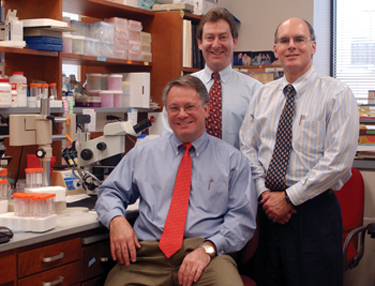
Douglas Vaughan, M.D., seated, is principal investigator of a $16 million grant to study hemostatic and thrombotic diseases. Stephen Davis, Ph.D., left, and Samuel Santoro, M.D., Ph.D., are two of the project leaders.
Photo by Dana Johnson
Thrombosis research gets $16 million boost
A team of Vanderbilt University Medical Center researchers will receive $16 million over the next five years to study why patients with diabetes and insulin resistance have a tendency to develop blood clots.
The National Heart, Lung, and Blood Institute (NHLBI) is funding Vanderbilt's Specialized Center of Clinically Oriented Research (SCCOR) program in Hemostatic and Thrombotic Diseases with nearly $3.2 million annually for five years.
Project leaders include scientists from the departments of Medicine, Pharmacology and Pathology, with cores led by collaborators in the departments of Biostatistics and Biochemistry.
The team consists of principal investigator Douglas Vaughan, M.D., and project leaders Samuel Santoro, M.D., Ph.D., Heidi Hamm, Ph.D., John Oates, M.D., and Stephen Davis, Ph.D.
The four cores are Bioanalytical and Biostatistics (Scott Williams, Ph.D., and Frank Harrell, Ph.D.), Murine Thrombosis and Imaging (Jeff Dendy, M.D.), Proteomics (Dan Liebler, Ph.D.) and an administrative core headed by Vaughan.
“We are thrilled. This really gives Vanderbilt a great opportunity to build one of the most important thrombosis research centers in the world,” said Vaughan, chief of VUMC's Division of Cardiovascular Medicine.
“We are studying the reasons why patients with diabetes, insulin resistance and obesity have an increased tendency to form clots that cause heart attacks and strokes.”
Vanderbilt is one of three institutions selected for this program, joining the University of Pennsylvania and the Cleveland Clinic.
SCCORs, which were redesigned two years ago to emphasize the performance of patient-oriented research, represent the largest awards supported by NHLBI outside of multi-center trials.
The newly developed SCCOR program places more emphasis on clinical research projects, reflecting the NHLBI's desire to capitalize on basic research advances by encouraging their translation to the clinical area.
One new requirement of the program is that at least half of the funded projects be clinical.
Santoro, chair of Pathology and professor of Biochemistry, said the Vanderbilt application was very “coherent and integrated.”
“It featured an all-star cast of project leaders and core directors coming together to do cutting edge work with a very strong clinical focus backed by superb basic science,” he said, adding that the team draws from five medical school departments.
“The plan that we developed melds the different perspectives and scientific approaches of an outstanding team of investigators to target the major systems relevant to thrombotic disease. The projects are a compelling blend of biochemistry, cell and molecular biology, molecular genetics, biophysics and clinical investigation. I am really proud of the way our team came together to complement one another in so many ways to strengthen each of the projects.”
Steven Gabbe, M.D., dean of the School of Medicine, said the award recognizes the strength of Vanderbilt's collaborative environment for research.
“You have faculty from three departments and cores representing support from several other departments. And we have the ability for all of these people to work together and really function, break down the silos if you will. We have come to take it for granted but it isn't this way at other institutions,” Gabbe said.













